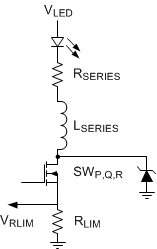ZHCSE87A October 2015 – September 2023 DLPA3000
PRODUCTION DATA
- 1
- 1 特性
- 2 应用
- 3 说明
- 4 Revision History
- 5 说明(续)
- 6 Pin Configuration and Functions
- 7 Specifications
-
8 Detailed Description
- 8.1 Overview
- 8.2 功能方框图
- 8.3
Feature Description
- 8.3.1 Supply and Monitoring
- 8.3.2 Illumination
- 8.3.3 DMD Supplies
- 8.3.4 Buck Converters
- 8.3.5 Auxiliary LDOs
- 8.3.6 Measurement System
- 8.3.7 Digital Control
- 8.4 Device Functional Modes
- 8.5 Register Maps
- 9 Application and Implementation
- 10Power Supply Recommendations
- 11Layout
- 12Device and Documentation Support
- 13Mechanical, Packaging, and Orderable Information
封装选项
机械数据 (封装 | 引脚)
- PFD|100
散热焊盘机械数据 (封装 | 引脚)
- PFD|100
订购信息
11.5 LED Connection
High switching currents run through the wiring connecting the external RGB switches and the LEDs. Therefore, special attention needs to be paid here. Two perspectives apply to the LED-to-RGB wiring:
- The resistance of the wiring, Rseries
- The inductance of the wiring, Lseries
The location of the parasitic series impedances IS depicted in Figure 11-4.
 Figure 11-4 Parasitic
Inductance (Lseries) and Resistance (Rseries) in Series
with LED
Figure 11-4 Parasitic
Inductance (Lseries) and Resistance (Rseries) in Series
with LEDCurrents up to 6 A can run through the wires connecting the LEDs to the DLPA3000. Some noticeable dissipation can easily be caused. Every 10 mΩ of series resistances implies for 6 A average LED current a parasitic power dissipation of 0.36 W. This might cause PCB heating, but more importantly, the overall system efficiency is deteriorated.
Additionally, the resistance of the wiring might impact the control dynamics of the LED current. It should be noted that the routing resistance is part of the LED current control loop. The LED current is controlled by VLED. For a small change in VLED (ΔVLED) the resulting LED current variation (ΔILED) is given by the total differential resistance in that path:

in which rLED is the differential resistance of the LED and Ron_SW_P,Q,R the on resistance of the strobe decoder switch. In this expression, Lseries is ignored since realistic values are usually sufficiently low to cause any noticeable impact on the dynamics.
All the comprising differential resistances are in the range of 25 mΩ to several 100s mΩ. Without paying special attention, a series resistance of 100 mΩ can easily be obtained. It is advised to keep this series resistance sufficiently low, that is, <50 mΩ.
The series inductance plays an important role when considering the switched nature of the LED current. While cycling through R, G, and B LEDs, the current through these branches is turned-on and turned-off in short-time duration. Specifically, turning-off is fast. A current of 6 A goes to 0 A in a matter of 50 ns. This implies a voltage spike of about 1 V for every 10 nH of parasitic inductance. It is recommended to minimize the series inductance of the LED wiring by:
- Short wires
- Thick wires / multiple parallel wires
- Small enclosed area of the forward and return current path
If the inductance cannot be made sufficiently low, a Zener diode needs to be used to clamp the drain voltage of the RGB switch, such it does not surpass the absolute maximum rating. The clamping voltage needs to be chosen between the maximum expected VLED and the absolute maximum rating. Take care of sufficient margin of the clamping voltage relative to the mentioned minimum and maximum voltage.